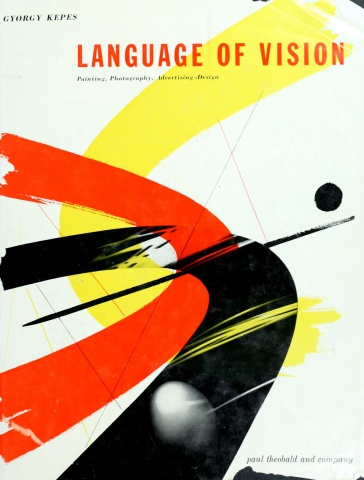Gyorgy Kepes: Language of Vision: Painting, Photography, Advertising-Design (1944–) [EN, ES, DE]
Filed under book | Tags: · advertising, art, art theory, bauhaus, colour, design, light, painting, perception, photography, vision

Noted painter, designer, theoretician Gyorgy Kepes analyzes the effect of visual language on the structure of human consciousness, in particular how the elements of line and form are perceived and how innovative types of perspective can lead to more dynamic representations in art. Over 300 photographs, drawings and illustrations.
With introductory essays by Siegfried Giedion and Samuel Ichiye Hayakawa
First published in 1944
Publisher Paul Theobald, Chicago, 1969
228 pages
Commentary: Ellen Lupton and J. Abbott Miller (1999), Leigh Anne Roach (Ph.D. dissertation, 2010).
Language of Vision (English, 1944/1969, 33 MB, no OCR)
El Lenguaje de la visión (Spanish, trans. Enrique L. Revol, 1969, added on 2017-6-21 via Valericke)
Sprache des Sehens (German, trans. Renate Pfriem and Almut v. Wulffen, 1971, 20 MB, added on 2019-12-3 via ARCH)
R. Bruce Elder: Harmony and Dissent: Film and Avant-garde Art Movements in the Early Twentieth Century (2008)
Filed under book | Tags: · abstract cinema, art history, avant-garde, cinema, colour, constructivism, dissent, experimental film, film, film history, film theory, marxism, modernism, music, occultism, productivism, revolution, suprematism, symbolism, theology

“R. Bruce Elder argues that the authors of many of the manifestoes that announced in such lively ways the appearance of yet another artistic movement shared a common aspiration: they proposed to reformulate the visual, literary, and performing arts so that they might take on attributes of the cinema. The cinema, Elder argues, became, in the early decades of the twentieth century, a pivotal artistic force around which a remarkable variety and number of aesthetic forms took shape.
To demonstrate this, Elder begins with a wide-ranging discussion that opens up some broad topics concerning modernity’s cognitive (and perceptual) regime, with a view to establishing that a crisis within that regime engendered some peculiar, and highly questionable, epistemological beliefs and enthusiasms. Through this discussion, Elder advances the startling claim that a crisis of cognition precipitated by modernity engendered, by way of response, a peculiar sort of “pneumatic (spiritual) epistemology.” Elder then shows that early ideas of the cinema were strongly influenced by this pneumatic epistemology and uses this conception of the cinema to explain its pivotal role in shaping two key moments in early-twentieth-century art: the quest to bring forth a pure, “objectless” (non-representational) art and Russian Suprematism, Constructivism, and Productivism.”
Publisher Wilfrid Laurier University Press, Waterloo, 2008
ISBN 1554580285, 9781554580286
480 pages
Review: David Sterritt (Quarterly Review of Film and Video, 2011).
PDF (updated on 2019-12-14)
Comments (7)Mary Hallock Greenewalt: Light: Fine Art the Sixth (1918)
Filed under booklet | Tags: · art, colour, light, synaesthesia, visual music

Greenewalt playing on her colour organ, the Sarabet, in 1925. (via CVM)
Between 1918 and 1926, the Beirut-born and Philadelphia-based visual music pioneer Mary Hallock Greenewalt (1871–1951) delivered a number of lectures to the Illuminating Engineering Society of Philadelphia. In them she outlined her project of the development of a colour organ. In an address of April 19, 1918, titled “Light: Fine Art the Sixth,” Greenewalt cited innovations in painting by the artist Corot which encouraged her to investigate light and colour as a means of enriching musical expression. Greenewalt also referenced reports of synaesthetes, people who experience cross-sensory perceptions such as those who see letters or numbers in different colors.
26 pages
A brief outline of all four lectures
Greenewalt’s biography from the Historical Society of Pennsylvania
View online (Archive.org)
Other formats (Archive.org)

